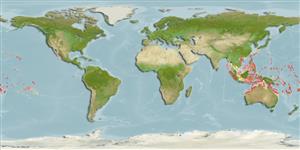>
Blenniiformes (Blennies) >
Tripterygiidae (Triplefin blennies) > Tripterygiinae
Etymology: Helcogramma: Greek, helkos, -eos, -ous = ulcer, sore + Greek, gramma = letter, mark (Ref. 45335).
More on author: Rosenblatt.
Environment: milieu / climate zone / depth range / distribution range
Ecología
marino asociado a arrecife; rango de profundidad 0 - 30 m (Ref. 90102), usually ? - 10 m (Ref. 6211). Tropical
Distribución
Países | Áreas FAO | Ecosistemas | Ocurrencias, apariciones | Point map | Introducciones | Faunafri
Western Central Pacific: widespread on the Pacific Plate, also Indonesia to Fiji, Niue, and American Samoa.
Tamaño / Peso / Age
Maturity: Lm ? range ? - ? cm
Max length : 3.7 cm SL macho / no sexado; (Ref. 6211)
Short description
Claves de identificación | Morfología | Morfometría
Espinas dorsales (total) : 16 - 18; Radios blandos dorsales (total) : 10 - 12; Espinas anales: 1; Radios blandos anales: 19 - 21. Males are dark-headed (Ref. 37816).
Adults inhabit surge-swept reef margins (Ref. 1602). Found on rock surfaces under ledges (Ref. 13227) of coral reefs covered with algae (Ref. 90102). Eggs are hemispherical and covered with numerous sticky threads that anchor them in the algae on the nesting sites (Ref. 240). Larvae are planktonic which occur primarily in shallow, nearshore waters (Ref. 94114).
Life cycle and mating behavior
Madurez | Reproducción | Puesta | Huevos | Fecundidad | Larva
Fricke, R., 1994. Tripterygiid fishes of Australia, New Zealand and the southwest Pacific Ocean (Teleostei). Theses Zool. 24:1-585. (Ref. 13227)
IUCN Red List Status (Ref. 130435: Version 2024-2)
Threat to humans
Harmless
Human uses
Herramientas
Special reports
Download XML
Fuentes de Internet
Estimates based on models
Preferred temperature (Ref.
123201): 26.6 - 29.4, mean 28.6 °C (based on 1341 cells).
Phylogenetic diversity index (Ref.
82804): PD
50 = 0.5000 [Uniqueness, from 0.5 = low to 2.0 = high].
Bayesian length-weight: a=0.00617 (0.00288 - 0.01322), b=3.04 (2.86 - 3.22), in cm total length, based on LWR estimates for this (Sub)family-body shape (Ref.
93245).
Nivel trófico (Ref.
69278): 3.1 ±0.3 se; based on size and trophs of closest relatives
Resiliencia (Ref.
120179): Alto, población duplicada en un tiempo mínimo inferior a 15 meses (Preliminary K or Fecundity.).
Fishing Vulnerability (Ref.
59153): Low vulnerability (10 of 100).
Nutrients (Ref.
124155): Calcium = 439 [174, 1,633] mg/100g; Iron = 2.49 [0.98, 5.52] mg/100g; Protein = 18 [16, 20] %; Omega3 = 0.104 [0.027, 0.410] g/100g; Selenium = 62.2 [13.3, 248.0] μg/100g; VitaminA = 71.1 [12.4, 442.4] μg/100g; Zinc = 4.8 [2.2, 8.7] mg/100g (wet weight);
